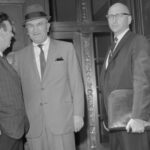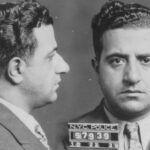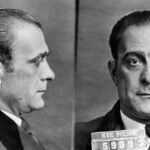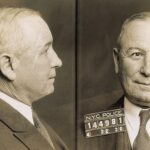Anthony Spilotro, often remembered as “Tony the Ant”, stands out as one of the most formidable figures in the history of organized crime in America. His life, marked by violence, power, and controversy, paints a vivid picture of the underworld’s workings during the 20th century. This comprehensive exploration delves into Spilotro’s life, from his early days in Chicago to his notorious reign in Las Vegas, and his eventual violent demise. His story is not just a tale of crime and punishment, but also a complex narrative about ambition, influence, and the dark allure of power. Spilotro’s journey through the ranks of organized crime offers a unique lens into the machinations of the mob and its impact on American society.
Early Life and Rise in the Chicago Outfit
The Making of a Mobster
Born on May 19, 1938, in Chicago, Illinois, Anthony Spilotro entered a world ripe for his future endeavors. Growing up in a tough neighborhood, he was the fourth of six sons in an Italian-American family. His father, Pasquale Spilotro Sr., owned a restaurant that was a known hangout for local mobsters, exposing Tony to the world of organized crime from a young age. This environment played a pivotal role in shaping his perceptions and ambitions. The young Spilotro witnessed the power and respect commanded by mobsters, setting the stage for his eventual entry into this clandestine world. His upbringing in a community where the lines between right and wrong were often blurred, coupled with the influence of mob figures who frequented his father’s restaurant, laid the foundation for his future in organized crime.
Stepping into the Underworld
Spilotro’s criminal activities began early. By his teenage years, he had already been arrested multiple times, signaling the start of a long and notorious criminal career. His aggressive nature and willingness to push boundaries quickly caught the attention of the Chicago Outfit, the city’s powerful organized crime syndicate. Spilotro’s early exploits were not just acts of rebellion, but strategic moves that demonstrated his potential as a valuable asset to the mob. His boldness, coupled with a keen understanding of the underworld’s dynamics, made him stand out among his peers. As he navigated the complex hierarchy of the Chicago Outfit, Spilotro’s reputation for being fearless and ruthless grew, earning him both respect and notoriety within the organization. This period of his life was crucial in developing the skills and connections that would later propel him to the forefront of the Las Vegas criminal scene.
The Move to Las Vegas
Establishing Control
In the early 1970s, the Chicago Outfit, recognizing the lucrative opportunities in the burgeoning city of Las Vegas, decided to expand its operations. Anthony Spilotro was handpicked for this critical mission, a testament to his rising status within the organization. His task in Las Vegas was multifaceted and complex. As the overseer of the Outfit’s operations, Spilotro’s primary role involved the management and protection of the Outfit’s illegal casino profits, a covert operation famously known as the “skim.” This practice involved siphoning off substantial amounts of money from casino earnings before they were recorded, thereby evading taxes and boosting the Outfit’s revenues.
Spilotro’s relocation to Las Vegas was not just a geographical move but represented a significant transformation in his criminal trajectory. In the glittering desert city, known both for its legalized gambling and its undercurrents of organized crime, Spilotro found a new arena to exercise his influence. He quickly adapted to the unique dynamics of Las Vegas, establishing connections and exerting control in a city that was rapidly becoming the new epicenter of illicit activities. His role in Las Vegas was crucial in expanding the Chicago Outfit’s influence beyond the confines of Illinois, marking a new chapter in the annals of organized crime.
The Hole in the Wall Gang
In the neon-lit landscape of Las Vegas, Spilotro embarked on one of his most notorious ventures: the formation of the “Hole in the Wall Gang.” This group, comprising a cadre of skilled burglars, safecrackers, and enforcers, quickly gained notoriety for their sophisticated and daring heists. The gang’s name derived from their signature method of operation: breaking into buildings by creating literal holes in the wall or ceiling, thereby circumventing conventional security measures.
The Hole in the Wall Gang was responsible for a series of high-profile burglaries and thefts, targeting everything from plush residences to secure commercial establishments. Their operations were marked by meticulous planning, precision, and a certain audacity that only a leader like Spilotro could inspire. These activities further solidified Spilotro’s reputation as a formidable and feared figure in the criminal underworld. Under his leadership, the gang not only amassed significant wealth but also reinforced the Chicago Outfit’s grip on the city’s illegal activities.
The exploits of the Hole in the Wall Gang were not merely criminal acts; they were statements of power and defiance against the law enforcement agencies that sought to curb their activities. Each successful heist was a testament to Spilotro’s ingenuity and the gang’s skill, reinforcing their status as legends in the Las Vegas underworld. However, this notoriety also brought increased scrutiny from law enforcement, setting the stage for a series of events that would eventually lead to Spilotro’s downfall.
The Reign of Violence
The M&M Murders
The M&M murders in 1962 stand as a stark testament to Anthony Spilotro’s brutal methods and his chilling efficiency in executing the mob’s justice. Tasked with disciplining Billy McCarthy and Jimmy Miraglia, two small-time thieves who had violated the mob’s unwritten rules, Spilotro turned the punishment into a display of savage brutality. The method he employed in the interrogation, using a vise to crush McCarthy’s head, was not just a means to an end but a message to anyone who dared cross the mob’s path. This gruesome act, which led to the eventual murders of both McCarthy and Miraglia, was a clear demonstration of Spilotro’s ruthlessness and his willingness to go to any lengths to uphold the mob’s authority.
The M&M murders were more than just another crime; they were a pivotal moment in Spilotro’s career. This act of extreme violence marked him as one of the most feared enforcers within the Chicago Outfit. It was a role that he embraced and executed with a cold and calculated precision. The notoriety he gained from this incident was a double-edged sword, cementing his reputation in the underworld while simultaneously beginning to draw the attention of law enforcement agencies.
A String of Crimes
Throughout the 1970s and into the early 1980s, Anthony Spilotro’s name became synonymous with a series of violent crimes that spanned murders, assaults, and robberies. His approach to crime was aggressive and unapologetic, characterized by a blatant disregard for subtlety or the potential consequences of his actions. This period in Spilotro’s life was marked by a relentless pursuit of power and control, often at the expense of any who stood in his way.
Spilotro’s tactics during this time were not just about achieving specific criminal objectives; they were about sending a message. Each act of violence further entrenched the fear and respect he commanded in the criminal underworld. However, this increasing notoriety came with its drawbacks. The brazen nature of his crimes and the growing body count began to attract significant attention, not just from local law enforcement but also from federal agencies. The media, too, became fixated on Spilotro, often portraying him as a symbol of the rampant lawlessness and corruption in Las Vegas and Chicago.
This period was also characterized by Spilotro’s expanding influence in both cities. In Las Vegas, he continued to oversee the lucrative casino skimming operations, while in Chicago, he maintained his status as a key enforcer and decision-maker within the Outfit. However, with increased power came increased scrutiny, and Spilotro soon found himself at the center of multiple investigations. His actions, once seen as valuable to the Outfit, began to be viewed as liabilities, setting the stage for internal conflicts and a growing sense of paranoia within the ranks of the organization.
The Downfall
The Affair and Internal Conflict
The beginning of Anthony Spilotro’s downfall can be traced back to his tumultuous affair with Geri McGee, the wife of Frank Rosenthal, a prominent casino executive and an influential associate of the Chicago Outfit. This illicit relationship was more than a mere scandal; it was a direct challenge to the unspoken rules of the mob world, where personal lives and business dealings were expected to remain separate. The affair was not just a betrayal of trust but a destabilizing factor in the delicate balance of power within the mob hierarchy.
Spilotro’s actions created a rift between him and his superiors in the Outfit. His once-valued loyalty was now in question, and his judgment was under scrutiny. The affair brought unwanted attention to the Outfit’s operations, particularly in Las Vegas, where discretion was paramount. It was a reckless move that signaled a shift in Spilotro’s priorities, from the collective interests of the organization to his personal desires. This shift contributed to a growing sense of distrust and resentment among his peers, ultimately isolating him within the very organization he had once served so faithfully.
Legal Troubles and the End
By the mid-1980s, the consequences of Spilotro’s actions had begun to catch up with him. His involvement in high-profile crimes had made him a target for law enforcement agencies. The FBI, along with local police departments, had intensified their efforts to dismantle the Outfit’s operations, and Spilotro was at the center of their investigations. The legal scrutiny he faced was relentless, with charges ranging from racketeering to murder.
The internal conflicts within the Outfit, exacerbated by Spilotro’s affair and his increasingly reckless behavior, hastened his downfall. In 1986, in a brutal display of mob justice, Anthony Spilotro and his brother Michael were savagely murdered. Their deaths marked a violent end to a life that had been defined by violence. It was a stark reminder of the harsh realities of the mob world, where loyalty was paramount and betrayal was met with the ultimate punishment.
Legacy and Cultural Impact
The Character in ‘Casino’
Anthony Spilotro’s life and career served as the inspiration for the character Nicky Santoro in Martin Scorsese’s film “Casino.” Portrayed by Joe Pesci, Santoro’s character is a vivid representation of Spilotro’s brutal and unapologetic nature. The film captures the essence of Spilotro’s life in the mob – his rise to power, his ruthless enforcement tactics, and his eventual downfall. It is a portrayal that immortalizes Spilotro’s impact on organized crime and underscores the violent and volatile nature of the world he inhabited.
A Symbol of Organized Crime
Anthony Spilotro remains a significant figure in the history of organized crime, a symbol of the era’s violence and power struggles. His story is a stark reminder of the dark underbelly of American society in the 20th century, where organized crime networks wielded significant influence. Spilotro’s life, marked by ambition, power, and ultimately betrayal, offers a window into the complexities of the mob world. His legacy continues to fascinate and serve as a cautionary tale about the perils of a life in organized crime.
The Enduring Fascination
Anthony Spilotro’s life story continues to fascinate and horrify. His journey from a small-time thief in Chicago to a feared mob enforcer in Las Vegas encapsulates the dark allure of the American underworld. While his life ended in violence, the legacy of Tony the Ant lives on, a testament to the complex and often brutal world of organized crime.







